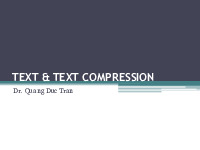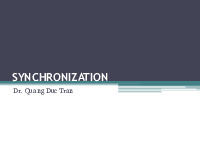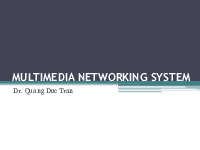


















Preview text:
MULTIMEDIA COMMUNICATION Dr. Quang Duc Tran Interactive VOD System Dr. Quang Duc Tran Introduction
• An IVOD system is capable of serving a large number of
end users to concurrently access large number of repositories of stored data.
• IVOD is an extension of VOD. In addition to the freedom
of choosing movies, users can interact with videos and
decide the viewing schedule (tricky play, i.e., fast forward, rewind, pause)
• Components include set-top-box at the client’s site, the
distribution network and the server System Architecture System Architecture Centralized IVOD System places processing servers and media achieves in a single site as a central node. Client Distributed IVOD System includes local processing servers and media servers. Clients’ requests are handled by local servers. System Architecture Distributed IVOD System Client User Input Device Visual Display Audio Display Network Interface Buffers and Decoder The Server Tape drive Tape controller
Disk array (Disk Scheduling, RAID) NAT Traversal
The overall architecture Characteristics
• Interactive Function (Play/Resume, Stop, Pause, Jump
Forward, Jump Backward, Fast Forward, Slow Down, Reverse)
• Quality of Service (Fast setup time, Continuity of media
streams, Transparency of the involvement of multiple media streams)
• Network (High speed networks, Latency, Jitter) Introduction Dr. Quang Duc Tran About ME • Contact Information ▫ Room B1-405
▫ Department of Data Communication and Computer Network
▫ School of Information and Communication Technology
▫ Hanoi University of Science and Technology
▫ E-mail: ductq@soict.hust.edu.vn ▫ Tel: (+84) (4) 38682596 Aim of this Module
• Describe the theory and operation of the major
technologies and equipment of relevance to the media and information industries
• Introduce you to the multimedia communications and its
range of applications and networking infrastructures
• Learn about different media types (text, images, speech,
audio and video) and applications (VoIP, Video on Demand, multimedia electronic mail, interactive television and others) Syllabus
• Topic 1: Introduction to Multimedia Communication
• Topic 2: Digitalization Principles • Topic 3: Text Processing
• Topic 4: Digital Image Processing • Topic 5: Audio Processing • Topic 6: Video Processing
• Topic 7: Multimedia Network
• Topic 8: Quality of Service & Synchronization
• Topic 9: RTP, RTCP & RTSP • Topic 10: SIP & H323 References 1. Jens-Rainer Ohm, “Multimedia Communication
Technology”, Springer-Verlag Berlin 2014. 2. William Stallings, “Data and Computer
Communication”, Prentice Hall – New Jersey 2007
3. J.D. Gibson, Editor, “Multimedia Communication”,
Academic Press, San Diego, CA, USA, 2001.
4. L.L Ball, “Multimedia Network Integration and
Management”, McGraw-Hill, 1996. References
5. S.J. Gibbs, and D. C. Tsichritzis, “Multimedia
Programming”, Addison-Wesley, New York, 1995. 6. W. Kou, “Digital Image Compression”, Kluwer publishers, London 1995.
7. S.J. Solari, “Digital Video and Audio Compression”, McGraw-Hill, 1997. Evaluation Method • Final written exam (70%)
▫ Held after the end of the lecturing period • Project/Midterm exam (30%)
▫ Written in group of 2-4 students
▫ Shall not have more than 10 pages (printed)
▫ Includes application and presentation Project Topics
1) Video On Demand service (Nginx)
2) Asterisk based Call Center (Asterisk)
3) Simple Video Chat Program (Socket Programming)
4) Video Conferencing System (BigBlueButton, Jitsi) 5) Media Center using KODI
6) FFMPEG: Video Codec Comparison
7) Video Streaming Server (Live555)
8) Video Recording (FFMPEG, RTSP) 9) Security: Secure RTP INTRODUCTION Dr. Quang Duc Tran





